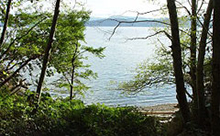Overview

Public access routes to the shoreline are created at the time of land subdivision under Section 75(1)(c) and (d) of the Land Title Act. As part of the subdivision process, the developer generally is required to dedicate a 20m wide access every 200 to 400m, depending on the size of the lots. (Some of the older accesses were as narrow as 3m and as wide as 60m.) These accesses are shown as public roadways on subdivision plans, though an actual road might not be constructed, and the land is administered by the Ministry of Transportation (MoT). The original developer is not responsible for making these shore accesses safe or usable, and the MoT has no mandate to maintain or improve the accesses for public use. That responsibility falls to the Commission, under licence of occupation from the MoT.
Galiano Access Points
Currently Galiano Island has 69 shore accesses and view points, not including the other types of water accesses at parks and government docks, with several more on the surrounding islands in the Commission’s service area. The Commission has improved and maintains 18 of these. 28 more are scheduled for improvement under the terms of the Licence of Occupation with the MoT. The remaining accesses, though open to the public, have difficult terrain or other aspects that make them less useful to the community, and these accesses are not included on the Commission’s Licence of Occupation.
- Galiano shore accesses given priority for improvement (PDF)
When improving a shore access, the Commission’s first responsibility is to make the access safe for the walking public. The work might involve clearing a path and constructing steps. The Commission puts up signs to clearly mark the access and to caution against trespassing on neighbouring properties. The Commission consults with the MoT to address parking and other issues raised by surrounding property owners. The Commission may also construct amenities such as benches at the shore accesses.
Philosophy

Shore accesses often represent remnants of undeveloped land that retains environmental, cultural, and archaeological values. Although the primary purpose of shore accesses is to provide the public with a route to the shoreline, the Commission recognizes the importance of protecting these other values. Before improving an access, the Commission inventories these features and considers ways to minimize impact on these assets.
When considering the priority for shore accesses to improve, the Commission, in consultation with the community, considers these criteria:
- Historical use (popular accesses for the community)
- Distribution in all neighbourhoods
- Ease of access
- Scenic values
- Recreation values
- Least impact to the environment
- Provision for parking
The Commission also considers improving view points for important scenic values even if there is no access to the water.
© Top Image courtesy of Rene Zich; bottom image courtesy of Minette Layne